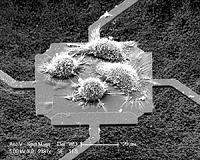 |
Washington DC (SPX) Nov 18, 2010 Using particles that are 1/100,000 the width of a human hair to deliver drugs to cells or assist plants in fighting off pests may sound like something out of a science fiction movie, but these scenarios may be a common occurrence in the near future. Carbon nanotubes, cylindrically shaped carbon molecules with a diameter of about 1 nanometer, have many potential applications in a variety of fields, such as biomedical engineering and medical chemistry. Proteins, nucleic acids, and drugs can be attached to these nanotubes and delivered to cells and organs. Carbon nanotubes can be used to recognize and fight viruses and other pathogens. However, results of studies in animals have also raised concerns about the potential toxicity of nanoparticles. Recent research by a team of researchers from China, led by Dr. Nan Yao, explored the effects of nanoparticles on plant cells. The findings of Dr. Yao and his colleagues are published in the October issue of the American Journal of Botany. Dr. Yao and his team of researchers isolated cells from rice as well as from the model plant species Arabidopsis. The researchers treated these cells with carbon nanotubes, and then assessed the cells for viability, damage to DNA, and the presence of reactive oxygen species. The researchers found an increase in levels of the reactive oxygen species hydrogen peroxide. Reactive oxygen species cause oxidative stress to cells, and this stress can result in programmed cell death. Dr. Yao and his colleagues discovered that the effect of carbon nanotubes on cells was dosage dependent-the greater the dose, the greater the likelihood of cell death. In contrast, cells exposed to carbon particles that were not nanotubes did not suffer any ill effects, demonstrating that the size of the nanotubes is a factor in their toxicity. "Nanotechnology has a large scope of potential applications in the agriculture industry, however, the impact of nanoparticles have rarely been studied in plants," Dr. Yao said. "We found that nanomaterials could induce programmed cell death in plant cells." Despite the scientists' observations that carbon nanotubes had toxic effects on plant cells, the use of nanotechnology in the agriculture industry still has great promise. The scientists only observed programmed cell death as a temporary response following the injection of the nanotubes and did not observe further changes a day and a half after the nanotube treatments. Also, the researchers did not observe death at the tissue level, which indicates that injecting cells with carbon nanotubes caused only limited injury. "The current study has provided evidence that certain carbon nanoparticles are not 100% safe and have side effects on plants, suggesting that potential risks of nanotoxicity on plants need to be assessed," Dr. Yao stated. In the future, Dr. Yao and colleagues are interested in investigating whether other types of nanoparticles may also have toxic effects on plant cells. "We would like to create a predictive toxicology model to track nanoparticles." Only once scientists have critically examined the risks of nanoparticles can they take advantage of the tremendous potential benefits of this new technology. Cong-Xiang Shen, Quan-Fang Zhang, Jian Li, Fang-Cheng Bi, and Nan Yao (2010). Induction of programmed cell death in Arabidopsis and rice by single-wall carbon nanotubes. American Journal of Botany 97(10): 1602-1609. DOI: 10.3732/ajb.1000073
Share This Article With Planet Earth
Related Links American Journal of Botany Darwin Today At TerraDaily.com
 Microsensors Offer First Look At Whether Cell Mass Affects Growth Rate
Microsensors Offer First Look At Whether Cell Mass Affects Growth RateChampaign IL (SPX) Nov 16, 2010 University of Illinois researchers are using a new kind of microsensor to answer one of the weightiest questions in biology - the relationship between cell mass and growth rate. The team, led by electrical and computer engineering and bioengineering professor Rashid Bashir, published its results in the online early edition of the Proceedings of the National Academy of Science. "It's ... read more |
|
| The content herein, unless otherwise known to be public domain, are Copyright 1995-2010 - SpaceDaily. AFP and UPI Wire Stories are copyright Agence France-Presse and United Press International. ESA Portal Reports are copyright European Space Agency. All NASA sourced material is public domain. Additional copyrights may apply in whole or part to other bona fide parties. Advertising does not imply endorsement,agreement or approval of any opinions, statements or information provided by SpaceDaily on any Web page published or hosted by SpaceDaily. Privacy Statement |